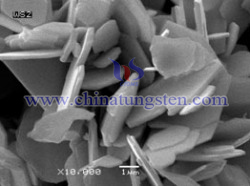Tungsten Disulfide MSDS
- Details
- Category: Tungsten Information
- Published on Wednesday, 01 June 2016 15:58
Material safety data sheet(MSDS) of tungsten disulfide(WS2):
Chemical Name: Tungsten Disulfide
Trade Name/Synonyms: Tungsten disulfide; Tungsten disulphide
Chemical Family: Refractory metal sulfide
CAS Number: 12138-09-9
Formula: WS2
Molecular Weight: 248.02

PHYSICAL DATA
Appearance & Odor: Grayish-black powder, no odor
Boiling Point: N/A
Vapor Pressure: (mm HG) N/A
Vapor Density: (air=1) N/A
Solubility in Water: Insoluble
Specific Gravity: (H2O=1) 7.4
Percent Volatile by Volume: 0
Evaporation Rate: N/A
How Best Monitored: Air sample
NON-HAZARDOUS INGREDIENTS
Material: Tungsten disulfide
Percent by Weight: 100
ACGIH TLV: 5MG/M3
HEALTH HAZARD DATA
ROUTES OF EXPOSURE: material can be inhaled, swallowed, or come in contact with the skin or eyes.
EFFECTS OF OVEREXPOSURE: dust and inhalation may cause mild irritation of the nose and throat. With the exception of TOW Russian studies that found early signs of pulmonary fibrosis in some workers exposed to tungsten trioxide, tungsten metal, and tungsten carbide, most studies have shown that insoluble tungsten compounds to be toxicologically inert. Skin and eye contact may cause irritation due to the abrasiveness of the dust. Recent scientific evidence indicates no adverse effects are likely from accidental ingestion of small amounts of the material.
EMERGENCY AND FIRST AID PROCEDURES: inhalation- if symptoms of pulmonary involvement develop, remove from exposure and seek medical attention; skin contact- if irritation occurs, thoroughly wash affected area with mild soap and water and prevent further contact, contact medical help if irritation persists; eye contact- if irritation occurs, flush with copious amounts of a water, contact medical help if irritation persists; ingestion- if substantial quantities are swallowed, give person (if conscious) a large quantity of water to drink, induce vomiting, and seek medical attention; carcinogenic assessment- NTP Annual Report, IARC monographs, et. al.) this material has not been identified as a known or suspected carcinogen by NTP, IARC, or OSHA.
FIRE & EXPLOSION HAZARD DATA
Flash Point: N/A
Flammability Limits: N/A
No fire hazard, use extinguishing agents suitable for surrounding fire. Special procedures: use a self-contained breathing apparatus to prevent inhalation of dust, mist or fumes that may be generated during fire fighting activities. No unusual fire or explosion hazards.
REACTIVITY DATA
Stability: Stable
Conditions to avoid: N/A
Incompatible Materials to Avoid: Contact with strong acids may generate hydrogen sulfide.
Hazardous Decomposition Products: Oxides of sulfur and tungsten may be evolved at extreme temperatures.
SPILL & LEAK PROCEDURES
If spilled or released- ventilate area of spill, clean-up using methods which avoid dust generation, such as vacuuming with appropriate filter, wet dust mop, or wet clean-up. If dust is generated, use approved niosh respirator. Disposal-dispose of in accordance with appropriate federal, state, and local regulations respiratory protection- use an appropriate niosh approved
respirator if airborne dust levels exceed the tlv, appropriate requirements set forth in 29 cfr 1910.134 should be met ventilation- use local exhaust which is adequate to limit exposure levels below tlv gloves-gloves are recommended eye protection recommended special precautions.
HANDLING AND STORAGE: Maintain good house keeping procedures to prevent acumulation of dust; use clean-up methods which minimize dust generation.
OTHER PRECAUTIONS:
wash throroughly after handling and before eating, smoking, and end of work shift; do not shake clothing to remove dust; avoid inhalation, ingestion, and direct skin contact.
| Tungsten Oxide Supplier: Chinatungsten Online www.tungsten-oxide.com | Tel.: 86 592 5129696; Fax: 86 592 5129797;Email:sales@chinatungsten.com |
| Tungsten News & Prices, 3G Version: http://3g.chinatungsten.com | Molybdenum News & Molybdenum Price: http://news.molybdenum.com.cn |



 sales@chinatungsten.com
sales@chinatungsten.com